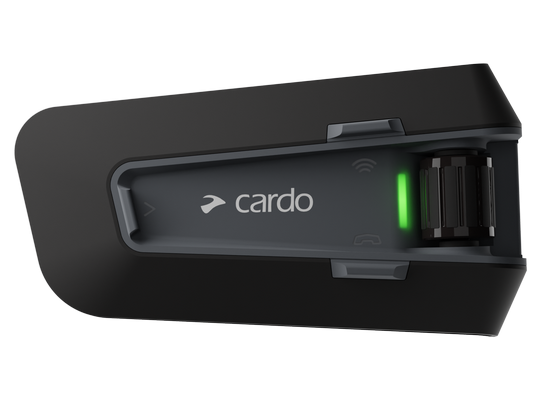Much like a house or a car, a motorcycle needs to be properly winterized to ensure that it stays in good shape while it’s not being used. From caring correctly for your tires to making sure that your fuel system stays clean, there’s lots to do—and it will give you a little bit more time with your bike before you put it to bed for a while. The motorcycle lovers at Cardo Systems have some tips for you to help keep your bike in great condition throughout the winter and make sure that it’s ready to rock again once the spring riding season rolls around.
Storage Space
First, let’s talk about where you should be storing your motorcycle for the winter. A garage with some kind of temperature control options is always the preferred choice. The more you can control the environment your bike is stored in, the safer it will be for the winter.

Although garage storage is always safer than outside, there are still some concerns to be aware of. Don’t put your bike somewhere in your garage that it will sit in direct sunlight, since this can damage your paint and leather. Opt for a cooler and darker corner instead. If your garage has moisture problems, look into ways to address them such as installing a dehumidifier or applying a coating to your floor.
If you’re making do without a garage, consider renting a storage unit with drive-up access, as these can be a great option for motorcyclists without garages. Garden sheds and other unheated storage spaces aren’t ideal, but they’ll at least keep the weather out (though they may have more moisture problems than a garage).
Storing your bike outside during the winter should be a last resort. There’s only so much that even the best motorcycle cover can do against repeated exposure to snow, rain, road salt, extreme cold and all of the other dangers of winter weather. If you have to store your bike outside, it’s a good idea to clean it soon after any kind of severe winter weather event to remove grime, and make sure to find a durable bike cover designed for heavy weather (see “Body” below).

Fluids
It’s important to get your motorcycle’s fluids changed and topped up before retiring it for winter. Check your levels of all of the following and replace them if they’ve worn out, or top them off as necessary:
- Brake fluid
- Clutch fluid
- Motor oil
- Coolant/antifreeze
Antifreeze is particularly important if you’re storing your bike in an unheated area (and absolutely critical if you’re storing it outside). While you’re at it, apply some motorcycle lubricant to key areas like your throttle, shifter and clutch cables to keep moisture and rust away from them.
Check your motorcycle’s manual before topping up fluids, and make sure you’re using the products recommended by the bike’s manufacturer. It’s also a good idea to change your oil filter before storing your bike. Alternatively, for those who like to get a fresh start come spring, you can drain all of your bike’s fluids before storing it and replace them when you’re ready to ride again.
Battery
Any kind of vehicle battery is prone to losing its charge during periods of inactivity, and motorcycle batteries are no different. Some motorcycle owners like to remove their battery completely during the winter, but this really isn’t necessary unless you’re storing your bike outside.

Generally, the preferred option for indoor storage is to use a battery maintainer. These devices feed a small, steady stream of current to your bike’s battery to keep it fresh and charged up. The best maintainers are called float maintainers, which use sensors to read the battery’s voltage and fill it up when it loses charge without overloading it.
So-called “trickle” maintainers are also available, but some motorcycle professionals consider them to be an inferior option. That’s because trickle chargers dispense a constant voltage no matter whether the battery is full or not, putting your battery at potential risk of damage from overcharging.
Many battery maintainers now feature both float and trickle mode options. However, no matter what kind of battery maintainer you’re using, make sure to give your battery terminals a good cleaning before hooking it up.
Fuel System
A fuel tank that spends the winter empty can be more vulnerable to rust, and it also increases the risk of your seals drying out. Thus, before you put a fuel injected bike to bed for the winter, give it a full tank of fuel and add some motorcycle fuel stabilizer. Refer to your bike’s instruction manual to find the recommended brand and the proper mix ratio of fuel to stabilizer. Once you’ve filled up your tank, fire up the engine for a few minutes and let the bike idle (or take a short ride around the block) so that the treated fuel can cycle through the system.
If you have an older bike with carburetors, your storage procedures may need to be a little different. Make sure the petcock valve is in the off position and drain your carb bowls to avoid fuel overflow from the float chamber that can damage other parts of your bike. If you have a carbureted bike but you don’t completely trust your petcock and needle valves to keep fuel where it belongs, get that situation sorted out with your mechanic before storing your bike.

Tires
The winter can be hard on motorcycle tires in a variety of ways, chief among which is usually the length of time that the bike spends sitting in the same position. Putting prolonged weight on your tires like this can create flat spots and uneven wear, reducing the lifespan of your tires.
If at all possible, try to store your bike in a way where the tires aren’t touching the ground to save them from being flattened by the weight of the bike. Motorcycle stands are a great way to do this, but they can be surprisingly pricey. For a more economical option, you can roll your bike’s tires a little bit every few days so that they accumulate wear evenly.
Fluctuations in temperature can also cause the rubber in your tires to expand and contract, which is another reason that it’s preferable to store your motorcycle in a temperature-controlled environment. Again, moisture is also a problem. It can seep up from a concrete floor, so put a small carpet or a sheet of plywood down to keep your tires and wheels dry.
Body
It’s also critical to take care of your bike’s body and paint during the winter. The most important way to do this is also one of the easiest: putting a motorcycle cover on your bike while it’s in storage. Features to look for in a motorcycle cover include:
- Breathability and ventilation features to prevent moisture trapping
- Made of a light but durable material such as water-resistant nylon or polyester
- Fits your motorcycle snugly without being too loose, too tight or so long that it pools on the floor
If you’re keeping your bike in a garage, a lighter model dust cover should be fine. For outside storage, however, you want a durable and waterproof bike cover (although it’s still important to have some ventilation, since you can’t avoid moisture altogether). An outdoor bike cover should also include grommets and tie-downs to prevent the wind from blowing it off.
Before you put the cover on, it’s a great idea to wash your bike thoroughly with a car washing sponge and a gentle cleaner. Then, apply a coat of wax to help prevent dirt, grime and rust from attacking your bike. Finally, hit your pipes with a few sprays of WD-40 to keep rust away in this critical area.
Security and Pest Control
It’s also important to make sure that your bike is as secure as it can be, wherever you keep it parked. For motorcyclists who can store their bikes in a garage, you’ll want to take all of the standard precautions like locking the door and windows. If you’re really concerned about theft from your garage, consider an alarm system and security lights.
Storage units are generally quite secure with a quality padlock. If you have to store your bike outside, use a combination of different types of motorcycle locks to secure it. Disc locks, chain locks, U-locks and electronic alarm systems all work well and are even more effective when combined.
Finally, there’s another type of insidious invader that can strike at your motorcycle during the winter: rodents. The little varmints love to nest in dark, sheltered spaces like motorcycle pipes, so grab some rubber exhaust plugs to seal your pipes and avoid any unpleasant surprises in the spring. Garaged bikes can be just as vulnerable to pests as outdoor ones, so don’t assume your ride is safe indoors.
Gear
Your gear is almost as important as your bike itself when it comes to having a safe and fun ride, so don’t forget to care for it properly when putting it away for the winter. From your helmet to your jacket and beyond, properly maintained gear will keep you safer and more comfortable when it’s time to ride again.

Your motorcycle helmet is your single most important piece of gear, so think carefully about how and where you’re going to store it. A padded helmet bag is an excellent option, since it takes up minimal space and you can take it on the go with you if you need to. If you have any motorcycle helmet communication systems or Bluetooth helmet speakers (like the Cardo Packtalk Bold or Cardo JBL 45mm Speaker Set), make sure to follow the directions for storing those as well. If you’ve got multiple riders in your household and/or multiple helmets to store, a helmet storage rack can also be a good choice.
Don’t neglect your other motorcycle riding gear, such as your riding jacket, riding pants, riding boots and other essentials. Each of these garments will have its own unique care instructions from the manufacturer, so consult the tag inside the clothes to learn how to preserve it properly. If you like keeping all of your riding gear together, get a sturdy suit bag or two to protect it all at once.
Parting is such sweet sorrow, as they say—but don’t worry, you’ll be firing up the pipes again before you know it. In the meantime, if you take the proper steps to protect your bike over the winter, it will thank you with a smooth ride and great performance when you rev it back up.







